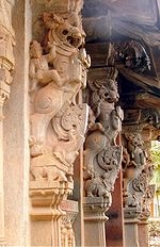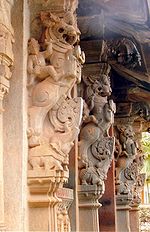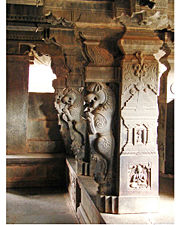
Keladi Nayaka
Encyclopedia
| Official language Official language An official language is a language that is given a special legal status in a particular country, state, or other jurisdiction. Typically a nation's official language will be the one used in that nation's courts, parliament and administration. However, official status can also be used to give a... |
Kannada |
| Capitals | Keladi Keladi Keladi is a temple town in Shimoga district of the state of Karnataka in India.Located about 8 KM from Sagara town.-History:It is interesting as the place whence the Ikkeri chiefs derived their origin, which is thus related :-... , Ikkeri Ikkeri Ikkeri is situated in Shimoga district of Karnataka state at about 6 km to the south of Sagara. The word Ikkeri in Kannada means "Two Streets". It was, from about 1560 to 1640 AD, the capital of the Keladi chiefs, afterwards removed to Bednur... |
| Government | Monarchy Monarchy A monarchy is a form of government in which the office of head of state is usually held until death or abdication and is often hereditary and includes a royal house. In some cases, the monarch is elected... |
| Preceding state | Vijayanagar Empire |
| Succeeding states | Kingdom of Mysore Kingdom of Mysore The Kingdom of Mysore was a kingdom of southern India, traditionally believed to have been founded in 1399 in the vicinity of the modern city of Mysore. The kingdom, which was ruled by the Wodeyar family, initially served as a vassal state of the Vijayanagara Empire... |


Karnataka
Karnataka , the land of the Kannadigas, is a state in South West India. It was created on 1 November 1956, with the passing of the States Reorganisation Act and this day is annually celebrated as Karnataka Rajyotsava...
including Shivamogga, practically the whole of coastal districts and parts of central districts of present day Karnataka
Karnataka
Karnataka , the land of the Kannadigas, is a state in South West India. It was created on 1 November 1956, with the passing of the States Reorganisation Act and this day is annually celebrated as Karnataka Rajyotsava...
till 1763 when they were overthrown by Hyder Ali
Hyder Ali
Hyder Ali was the de facto ruler of the Kingdom of Mysore in southern India. Born Hyder Naik, he distinguished himself militarily, eventually drawing the attention of Mysore's rulers...
, the king of Mysore.
They played an important part in the history of Karnataka, during a time of confusion and fragmentation that generally prevailed in South India
South India
South India is the area encompassing India's states of Andhra Pradesh, Karnataka, Kerala and Tamil Nadu as well as the union territories of Lakshadweep and Pondicherry, occupying 19.31% of India's area...
after the fall of the Vijayanagar Empire. They were Veerashaivas (Lingayats)and linked to banijiga
Balija
Balija is a social group spread across the Indian states of Andhra Pradesh , Tamil Nadu, Karnataka and Kerala...
merchant community but devoted to the Shringeri peetha.
The Nayaka clan
Chaudappa (1499 - 1530) from Keladi was the earliest chieftain to rule the area surrounding Shivamogga was a lingayath and malavara caste.Sadashiva Nayaka (1530 - 1566) was an important chieftain in the Vijayanagar Empire and earned the title Kotekolahala from emperor Aliya Rama Raya
Aliya Rama Raya
Rama Raya , popularly known as "Aliya" Rama Raya, was the progenitor of the "Aravidu" dynasty of Vijayanagar Empire. This dynasty, the fourth and last to hold sway over the Vijayanagara Empire, is often not counted as a ruling dynasty of that empire, for reasons delineated below. Rama Raya...
for his heroics in the battle of Kalyani.
The coastal provinces of Karnataka came under his direct rule. He moved the capital to Ikkeri
Ikkeri
Ikkeri is situated in Shimoga district of Karnataka state at about 6 km to the south of Sagara. The word Ikkeri in Kannada means "Two Streets". It was, from about 1560 to 1640 AD, the capital of the Keladi chiefs, afterwards removed to Bednur...
some 20 km. from Keladi
Keladi
Keladi is a temple town in Shimoga district of the state of Karnataka in India.Located about 8 KM from Sagara town.-History:It is interesting as the place whence the Ikkeri chiefs derived their origin, which is thus related :-...
.
Sankanna Nayaka (1566 - 1570)
Chikkasankanna (1570 - 1580) was an opportunistic ruler who took advantage of the confusion in the Vijayanagar Empire following its defeat at Tallikotaand grabbed a few provinces in Uttara Kannada district.
Ramaraja Nayaka (1580 - 1586)
Hiriya Venkatappa Nayaka (1586 - 1629) is considered by scholars as ablest monarch of the clan. He completely freed himself from the overlordship of the relocated Vijayanagar rulers of Penugonda. Italian traveller Pietro Della Valle
Pietro Della Valle
Pietro della Valle was an Italian who traveled throughout Asia during the Renaissance period. His travels took him to the Holy Land, the Middle East, Northern Africa, and as Far as India.-Biography:...
, who visited his kingdom in 1623, called him an able soldier and administrator. In his reign the kingdom expanded so that it covered coastal regions, Malnad
Malnad
Malenadu is a region of Karnataka state in South India. Malenadu covers the western and eastern slopes of the Western Ghats, roughly 100 kilometers in width. Malenadu covers portions of the Shimoga, Chikmagalur, Uttara Kannada, Kodagu and Hassan districts....
regions, and some regions to the east of the western Ghats
Western Ghats
The Western Ghats, Western Ghauts or the Sahyādri is a mountain range along the western side of India. It runs north to south along the western edge of the Deccan Plateau, and separates the plateau from a narrow coastal plain along the Arabian Sea. The Western Ghats block rainfall to the Deccan...
of present day Karnataka. He is also known to have defeated the Adilshahis of Bijapur in Hanagal. Though a Virashaiva by faith, a valmiki nayaka king converted to veerashaivism, he built many temples for Vaishnavas and Jains and a mosque for Muslims.
Virabhadra Nayaka (1629 - 1645) faced many troubles from the start, including competition from rival Jain chieftains of Malenad for the throne of Ikkeri and invasion by the Sultanate armies of Bijapur. Ikkeri was plundered by the Bijapur army during his time.
Shivappa Nayaka
Shivappa Nayaka
Shivappa Nayaka , also known as Keladi Shivappa Nayaka, was a notable ruler of the Keladi Nayaka Kingdom. The Keladi Nayakas were successors of the Vijayanagara Empire in the coastal and Malnad districts of Karnataka, India, in the late 16th century...
(1645 - 1660) is widely considered as the ablest and greatest of the Keladi rulers. He was the uncle of Virabhadra Nayaka. Shivappa deposed his nephew to gain the throne of Keladi. He was not only an able administrator; he also patronised literature and fine arts. His successful campaigns against the Bijapur sultans, the Mysore kings, the Portuguese, and other Nayakas of the neighbouring territories east of the western ghats
Western Ghats
The Western Ghats, Western Ghauts or the Sahyādri is a mountain range along the western side of India. It runs north to south along the western edge of the Deccan Plateau, and separates the plateau from a narrow coastal plain along the Arabian Sea. The Western Ghats block rainfall to the Deccan...
helped expand the kingdom to its greatest extent, covering large areas of present day Karnataka. He gave importance to agriculture and developed new schemes for collection of taxes and revenues which earned him much praise from later British officials. A statue of him and the palace built by him containing many artifacts of his times are reminders of the respect he has earned even from the present generation of people of the region.
Chikkavenkatappa Nayaka (1660 - 1662)
Bhadrappa Nayaka (1662 - 1664)
Somashekara (1664 - 1672) The King who was once a good administrator, gave up his interest in administration after his associastion with a dancer named Kalavati. Bharame Mavuta, a relative of Kalavati slow poisoned the king which eventually led to his death.
Keladi Chennamma (1672 - 1697) She was the daughter of kotepura siddappa setti a
lingayath banajiga merchant community. when somashekara nayaka went to visit rameswaram then he seen
and loved her. she was brave and pretty women. She was an able ruler who some scholars say allied with the Maratha Shivaji and later his son Sambhaji to defeat all rival claimants to the throne. She gave shelter to Chhatrapathi Rajaram when he fled from the Mughal
Mughal Empire
The Mughal Empire , or Mogul Empire in traditional English usage, was an imperial power from the Indian Subcontinent. The Mughal emperors were descendants of the Timurids...
army. Chennamma of Keladi is well remembered by local people through tales of her bravery.
Basavappa (1697 - 1714)he was a brave ruler and he was adopted by rani chennammaji from their relative
markappa chetty of a banajiga merchant who is residing at bedanur
Somashekara (1714 - 1739)
Kiriya Basavappa (1739 - 1754)
Chennabasappa (1754 - 1757)
Queen Virammaji (1757 - 1763) was defeated by Hyder Ali and the Keladi kingdom merged with the Kingdom of Mysore
Kingdom of Mysore
The Kingdom of Mysore was a kingdom of southern India, traditionally believed to have been founded in 1399 in the vicinity of the modern city of Mysore. The kingdom, which was ruled by the Wodeyar family, initially served as a vassal state of the Vijayanagara Empire...
.
Decline and the end
For more than two hundred years the kingdom controlled the coastal and malnad regions of present day Karnataka and fostered a rich tradition of trade with the English, the Portuguese, and the Dutch. However, in the period of gloom brought about by the fall of the last great Hindu empire, the Vijayanagar empire, constant wars—campaigns against local chieftains and the Mysore Kingdom and the harassment of the Marathas -- finally drained the treasury and resulted in the end of the kingdom.Literature
KannadaLinganna wrote Keladinripavijayam, Shivagita by Tirumalabhatta are important works of literature.
Sanskrit
Shivatattvaratnakara of king Basavappa, Bhattoji Dikshita wrote Tattva Kausthuba, Ashvapandita wrote Manapriya.
Architecture
The Keladi Nayakas built some fine temples in Ikkeri and Keladi using a combination of late Kadamba, Hoysala, VijayanagarVijayanagara Empire
The Vijayanagara Empire , referred as the Kingdom of Bisnaga by the Portuguese, was an empire based in South Indian in the Deccan Plateau region. It was established in 1336 by Harihara I and his brother Bukka Raya I of the Yadava lineage. The empire rose to prominence as a culmination of attempts...
, and Dravida styles. The use of granite for their construction shows they simply followed the Vijayanagar model of architecture. The Aghoreshwara temple at Ikkeri and the Rameshwara temple at Keladi are the best examples of the Nayakas' art. Vijayanagar-style pillars with hippogryphs are common; called yali columns (depiction of horses and lions as seen in Hampi
Hampi
Hampi is a village in northern Karnataka state, India. It is located within the ruins of Vijayanagara, the former capital of the Vijayanagara Empire. Predating the city of Vijayanagara, it continues to be an important religious centre, housing the Virupaksha Temple, as well as several other...
) is found here. These are pillars with lions, either with their forepaws raised or simply in a sitting position, and pillars with a mythical horse-like animal with front legs raised, balancing on its rear legs, and with an armed rider on its back which are worth seeing at Ikkeri. A roof sculpture depicting a Gandaberunda
Gandaberunda
The Gandaberunda is a two-headed mythological bird of Hindu mythology thought to possess magical strength. It is used as the official emblem by the Karnataka government and it is seen as an intricately sculptured motif in Hindu temples.- Story :The Ganda Berunda took physical form in the Narasimha...
, the mythical two-headed bird of Karnataka, is found in Keladi. Also, in the Rameshwara temple, a pillar sculpture shows Maratha Rajaram with Keladi Chennamma (history has it that Rajaram was protected by the queen when he was on the run from the Mughals).
Religious Tolerance
The Keladi Nayakas invited Kazi Mahmoud who was a grandson of chief kazi of Adil Shahi kingdom of Bijapur to settle in BhatkalBhatkal
Bhatkal is also known as Batecala in some historical text especially in Portuguese history.Once ruled by Jain King Bhattakalanka and thus the name. Bhatkal is a port town in Uttara Kannada district of Karnataka, India 126 km from Karwar. The town lies on NH-17 running between Mumbai and Mangalore...
. The revenue of Tenginagundi village was gifted to Kazi Mahmoud. The kazi family of Bhatkal is popularly known as Temunday Family due the ownership of lands in Tenginagundi. Many Nawayath
Nawayath
The Nawayaths are a small Muslim community concentrated mostly in coastal Uttara Kannada. It is an ethnic society, having its own unique traditions and distinct cultural identity...
Muslims were appointed in the administrative positions. The families of these nobles Nawayath
Nawayath
The Nawayaths are a small Muslim community concentrated mostly in coastal Uttara Kannada. It is an ethnic society, having its own unique traditions and distinct cultural identity...
still use their surnames as Ikkeri
Ikkeri
Ikkeri is situated in Shimoga district of Karnataka state at about 6 km to the south of Sagara. The word Ikkeri in Kannada means "Two Streets". It was, from about 1560 to 1640 AD, the capital of the Keladi chiefs, afterwards removed to Bednur...
and are mainly settled in and around Bhatkal
Bhatkal
Bhatkal is also known as Batecala in some historical text especially in Portuguese history.Once ruled by Jain King Bhattakalanka and thus the name. Bhatkal is a port town in Uttara Kannada district of Karnataka, India 126 km from Karwar. The town lies on NH-17 running between Mumbai and Mangalore...
. The Golden Kalasa on the dome of Bhatkal
Bhatkal
Bhatkal is also known as Batecala in some historical text especially in Portuguese history.Once ruled by Jain King Bhattakalanka and thus the name. Bhatkal is a port town in Uttara Kannada district of Karnataka, India 126 km from Karwar. The town lies on NH-17 running between Mumbai and Mangalore...
Jamia Masjid popularly known as 'Chinnada Palli' meaning 'Golden Mosque' is believed to be a generous gift from Keladi rulers.

